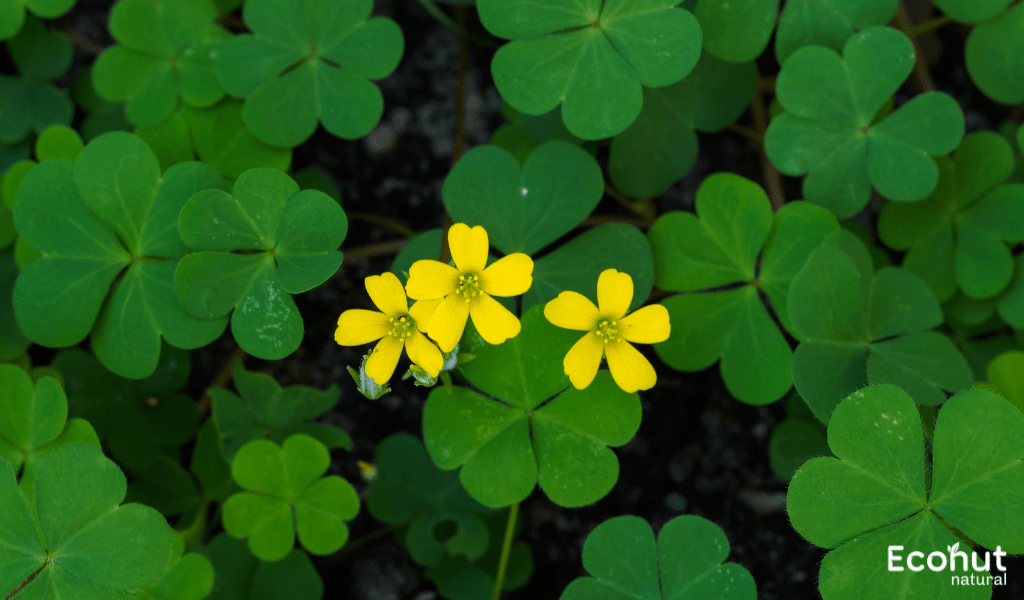Changeri (Oxalis corniculata) is a sour-tasting medicinal herb also known by the common names Indian penny wood, creeping wood sorrel, Procumbent yellow, and creeping oxalis. It is effective in treating ailments of the stomach and liver. Its blooms taste sour because of the oxalic acid and calcium oxalate they contain.
The leaves of this herb taste harsh and astringent. In countries such as Canada, its self-pollinating blossoms are used as glasshouse weed, despite the fact that they may grow swiftly in open places. It’s edible and goes well with salads.
Description
Changeri (Oxalis corniculata) is creeping weed that is frequently seen by roadsides, hedges, gardens, and waste areas. Changeri plant branches lie on the ground and begin to root to produce new plants.
Botanical Name:
Oxalis corniculata
Family:
Oxalidaceae
Leaves:
Trifoliate leaves are separated into three leaflets that resemble hearts or clover shapes. The leaflets have a smooth, slightly shiny surface and are usually tiny, 1-2 cm in length.
Flowers:
Small flowers with five yellow petals that can be single or grouped because they are fragile, the blossoms frequently droop, especially in shaded areas. Their habit of closing up at night or in the absence of direct sunshine has earned them the moniker “sleeping beauty.”
Fruits:
Capsules, narrow and cylindrical, that appears after flowering. When fully grown, these capsules burst open, releasing tiny, black seeds in a burst.
Habitat:
Primarily indigenous to Hawaii and southern Europe is Oxalis. It can be found in America’s tropical areas. It can be found in China, Taiwan, India, Pakistan, Afghanistan, and Japan in Asia. It is primarily found on roadsides, wastelands, highlands, open gardens, and grasslands in India.
Parts Used:
- Leaves
- Flowers
Dosage:
- Decoction – 15-30ml
Chemical Constituents
The entire plant has high vitamin C content and is edible. The plant’s separated phytochemical contents include fatty acids, glycosides, tannins, phytosterols, phenol, flavonoids, and galacto-glycero lipid in addition to volatile oils.
Other Language Names of Changeri (Oxalis corniculata)
Kannada name – Pullamouradi, Sivargee
Malayalam – Pulliparel
Bengali name – Amrul
Guajarati name – Ambolee, Changeri
Marathi name – Ambutee, Ambatee
Tamil name – Paliakiri
Telugu name – Pulichinta
English name – Yellow wood sorrel, creeping oxalis, creeping lady’s sorrel, creeping wood sorrel, procumbent yellow sorrel
Hindi name – Amrul, Changeri
Nepalese name – Caremalaa
Portuguese name – Azedinha, Erva-azedo
Spanish name – Acederilla, Vinagrera
Turkish name – Eksi yonca
Brazil name – Trevo-azedo
Urdu name – Teen patiya, Changeri
Arabic name – Hhamdid
French name – Alleluia, Oxalis cornicluee
German name – Gelber saurerklee, Gehornter sauerklee
Italian name – Ossalide corniculata
Chinese name – Cu-jiang-cao
Fiji name – Matakonikoni
Philippines name – Salamagi, Kanapa
Sweden name – Krpoxalis
Scientific Classification
| Kingdom | Plantae |
| Order | Oxalidales |
| Family | Oxalidaceae |
Ayurvedic Properties
Hindi/Sanskrit
- Rasa -Amla, Kashaya
- Guna -Laghu,Rooksha
- Virya -Ushna
- Vipaka -Amla
English
- Taste -Sour, Astriongent
- Physical Property-Light, Dry
- Potency- Hot
- Metabolic Property (After Digestion)-Sour
Changeri (Oxalis corniculata) Uses
Skin diseases:
Changeri (Oxalis corniculata) contains antioxidants that are very good at removing dangerous preradicals from the body that lead to infection, which is why it plays a significant role in skin problems. This herb’s antipruritic properties reduce irritation brought on by psoriasis, eczema, scabies, sunburn, etc. Its medicinal ingredients enhance the healing process in addition to preventing warm invasion.
Piles:
It exhibits hemostatic action in piles, which plays a significant part in treating files by giving the affected area a soothing, cooling sensation. Its leaf powder can be combined with buttermilk.
Insomnia:
Changeri, or Oxalis corniculata, lowers the stress hormone cortisol, which in turn lowers stress and lengthens the quality of sleep. This herb is used as a nerve tonic to strengthen the nerves and to quiet the mind.
Changeri (Oxalis corniculata) Benefits
Digestive:
Stomach ulcers, diarrhea, and dysentery may benefit from changeri’s astringent and anti-inflammatory qualities. Research indicates that it may alleviate inflammation and calm the gastrointestinal system.
Skin Soother:
Because changeri has anti-inflammatory qualities, it can be applied topically to treat eczema and other skin diseases. Research suggests that it could lessen discomfort and itching.
Liver Support:
Changeri may have hepatoprotective benefits, which means it may shield the liver from harm, according to some research.
Fever:
A common fever causes your body temperature to rise. Its leaves’ extract aids in lowering the temperature.
Stomach disorders:
When consumed raw, the leaves can help ease all stomach discomfort and stimulate your appetite. By giving the stomach the tools to right its wrongs, it improves the stomach.
Insomnia:
Before going to bed, mix some of its fresh juice with castor oil and gently massage the scalp. You’ll undoubtedly have a good night’s sleep. It eliminates the sleeplessness you were experiencing.
Lowers Inflammation:
Its leaves contain a treatment that you can apply to lessen pain and inflammation, which will inevitably decrease.
Don’t miss: Kaunch Beej (Mucuna Pruriens) – Uses, Benefits, Dosage & Side Effects
Changeri (Oxalis corniculata) Side Effects
Digestive Upset:
Because Changeri is an astringent, some people may develop upset stomach or diarrhea after taking large doses of it.
Pregnancy and Breastfeeding:
The safety of Changeri for expectant or nursing mothers is not well understood. As a safety measure, it is preferable to avoid it.
Conclusion
Changeri (Oxalis corniculata) is a very helpful remedy for conditions including dysentery, diarrhea, digestion issues, sleeplessness, and bad breath. Although it has many medical benefits, you should take the recommended dosage as directed by your physician.
FAQS
What are the benefits of Changeri?
The leaves of the changeri offer analgesic qualities. As a result, changeri leaf tea has instant benefits for treating stomach aches and other physical pains. You can prepare and consume a decoction of Changeri leaves for this. The Changeri leaves should be boiled in water to create a decoction.
Which changeri component is utilized medicinally?
Changeri leaves and flowers are beneficial.
What adverse effects does Changeri have?
Because too much of it ties up calcium’s availability, oxalic acid can result in nutritional deficiencies. It should not be used in cases of gout, diabetes mellitus, rheumatoid arthritis, etc.
What is the use of Changeri leaves?
The leaves of the changeri offer analgesic qualities. As a result, changeri leaf tea has instant benefits for treating stomach aches and other physical pains. You can prepare and consume a decoction of Changeri leaves for this. The Changeri leaves should be boiled in water to create a decoction.

